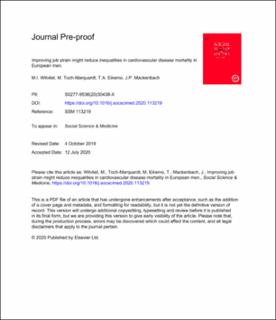| dc.contributor.author | Witvliet, Margot I. | |
| dc.contributor.author | Toch-Marquardt, Marlen | |
| dc.contributor.author | Eikemo, Terje Andreas | |
| dc.contributor.author | Mackenbach, Johan P. | |
| dc.date.accessioned | 2021-01-25T13:07:13Z | |
| dc.date.available | 2021-01-25T13:07:13Z | |
| dc.date.created | 2020-08-19T10:38:13Z | |
| dc.date.issued | 2020 | |
| dc.identifier.issn | 0277-9536 | |
| dc.identifier.uri | https://hdl.handle.net/11250/2724568 | |
| dc.description.abstract | Unfavorable psychosocial working conditions can lead to cardiovascular disease (CVD) mortality. Lower-occupational groups typically experience unfavorable psychosocial working conditions as compared to higher-occupational groups. We investigate the extent to which CVD mortality inequalities might be reduced if psychosocial working conditions for manual workers are raised to the level experienced by non-manual workers (upward-leveling scenario). We also investigate what would occur if psychosocial working conditions among manual and non-manual workers are raised to better levels as observed in the ‘ideal’ region (best practice scenario).
Individual-level CVD mortality data from 12 European countries were obtained from the EURO-GBD-SE project (1998–2007). Psychosocial working conditions data (i.e. job strain) were extracted from the European Working Conditions Survey (2005) and rate ratios from literature reviews. Population attributable fractions (PAF) and two counterfactual scenarios (namely, upward-leveling scenario and best-practice scenario) were developed to examine employed male non-manual and manual workers.
Results appeared to show that CVD mortality might be reduced in men when unfavorable psychosocial working conditions are improved for manual workers (PAF = 7.7%, 95% CI: 6.5–10.0). The upward-leveling scenario seems to reduce CVD mortality inequalities for manual workers, by 13–74%. Best-practice scenario shows the largest reduction in CVD mortality in the Baltic region (87 deaths per 100,000 person years).
Findings suggest that rendering job strain in manual workers to the level experienced by non-manual workers might substantially reduce CVD mortality inequalities in European men. | en_US |
| dc.language.iso | eng | en_US |
| dc.publisher | Elsevier | en_US |
| dc.rights | Attribution-NonCommercial-NoDerivatives 4.0 Internasjonal | * |
| dc.rights.uri | http://creativecommons.org/licenses/by-nc-nd/4.0/deed.no | * |
| dc.title | Improving job strain might reduce inequalities in cardiovascular disease mortality in european men | en_US |
| dc.type | Peer reviewed | en_US |
| dc.type | Journal article | en_US |
| dc.description.version | acceptedVersion | en_US |
| dc.source.journal | Social Science and Medicine | en_US |
| dc.identifier.doi | https://doi.org/10.1016/j.socscimed.2020.113219 | |
| dc.identifier.cristin | 1823984 | |
| dc.description.localcode | "© 2020. This is the authors’ accepted and refereed manuscript to the article. Locked until 26.7.2023 due to copyright restrictions. This manuscript version is made available under the CC-BY-NC-ND 4.0 license http://creativecommons.org/licenses/by-nc-nd/4.0/ " | en_US |
| cristin.ispublished | false | |
| cristin.fulltext | original | |
| cristin.qualitycode | 2 | |

